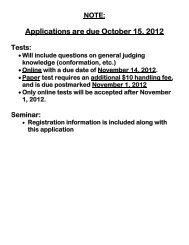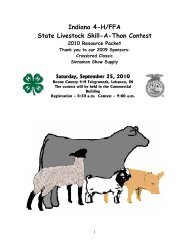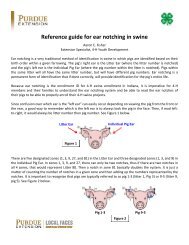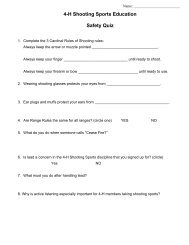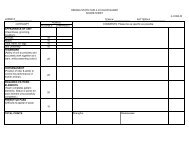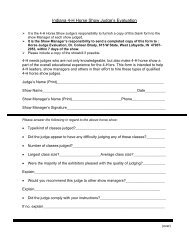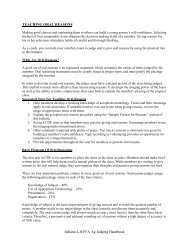Indiana Entomology CDE - Indiana 4-H
Indiana Entomology CDE - Indiana 4-H
Indiana Entomology CDE - Indiana 4-H
You also want an ePaper? Increase the reach of your titles
YUMPU automatically turns print PDFs into web optimized ePapers that Google loves.
<strong>Indiana</strong> <strong>Entomology</strong> <strong>CDE</strong><br />
Purpose<br />
The primary purpose of this event is to increase youth understanding of insects, control<br />
measures, and integrated pest management.<br />
The Area <strong>Entomology</strong> Career Development Event<br />
The Area <strong>Entomology</strong> Career Development Event is composed of insect identification and<br />
quiz questions. Juniors and Seniors will have different quizzes. Questions will be taken from<br />
the Resources listed below.<br />
Scoring: 40 specimens – 3 points for each common name (ma. 120) and 1 point for each<br />
order (max. 40) for a total of 160 (120+40) points for the insect identification. Quiz: 20<br />
questions, 2 point each for a total of 40 points. Maximum total points 200.<br />
Points<br />
Insect Identification (40 specimens)<br />
Common name – 3 points each 120<br />
Order – 1 point each 40<br />
Quiz – 20 questions at 2 points each 40<br />
Total 200<br />
All preliminary contests should be conducted in such a manner as to prepare contestants for the<br />
State contest. We recommend participants are allowed 20 seconds per identification, assuming<br />
that this will be adjusted as needed.<br />
Area quizzes will be sent to Area Coordinators in October. If possible, use Scantron for at least<br />
part of the <strong>CDE</strong> to familiarize youth with them before they reach the State <strong>CDE</strong>.<br />
The State <strong>Entomology</strong> Career Development Event<br />
The State <strong>Entomology</strong> Career Development Event is composed of insect identification and quiz<br />
questions. Participants will complete both parts at the same time as they sit at a table and pass<br />
Riker mounts. Some Riker boxes will contain insects for identification and some will contain<br />
questions.<br />
1. Fifty (50) insect or insect related specimens mounted in individual Riker mounts will be<br />
identified both to order and common name. Contestants from both the junior and senior<br />
divisions will be required to choose the correct names (multiple choice) and indicate the<br />
correct answer on a Scantron answer sheet.<br />
2. Specimens for the state contest will be taken from the list of insects given in this<br />
Handbook. Specimens will be adult form.<br />
3. Juniors and Seniors will have different quizzes. Multiple choice and/or true & false<br />
questions will be taken from the Resources listed below.<br />
4. Time per specimen/question: 20 seconds, although this will be altered if needed.<br />
Additional time is generally allotted at the start of the contest, to allow participants to<br />
become comfortable with our procedure of passing specimens to the next contestant<br />
while remaining seated.
<strong>Indiana</strong> <strong>Entomology</strong> <strong>CDE</strong><br />
5. Scoring: 3 points for each common name and one point for each order for a total of 150<br />
points for the insect identification. Quiz: 25 questions, 2 points each for a total of 50<br />
points. Maximum total points 300:<br />
Insect Identification (50 specimens)<br />
Points<br />
Common name – 3 points each 150<br />
Order – 1 point each 50<br />
Quiz – 20 questions at 2 points each 50<br />
Total 250<br />
In the event of a tie high score, the tie will be broken by favoring the individual or team having<br />
the highest score on the quiz questions. If a tie still exists, the tie will be broken by favoring the<br />
individual or team answering a question (or questions) given by the contest coordinator.<br />
Resources<br />
Questions for the <strong>Entomology</strong> <strong>CDE</strong> will be taken from the following resources:<br />
Juniors<br />
• How to Make an Awesome Insect Collection! (ID-401) – available at:<br />
o online<br />
o purchase from The Education Store<br />
o App<br />
• Awesome Insect Fact n’ Photo Cards (ID-415) – available at:<br />
http://extension.entm.purdue.edu/4hyouth/<br />
Seniors<br />
• Junior resources (see above)<br />
• Who Let the Bugs Out (ID-402) – available:<br />
o online<br />
o purchase from The Education Store (coming soon)<br />
o APP<br />
Common names & order<br />
Note: There are 150 insects that youth may be asked to identify. They are listed below by order.<br />
Specimen boxes will contain either the adult stage or both the adult and growing stages, except<br />
where noted.<br />
Common Name – Order Name<br />
Common Name – Order Name<br />
1. Alfalfa weevil - Coleoptera 1. Carpenter bee - Hymenoptera<br />
2. American cockroach - Dictyoptera 31. Carrion beetle - Coleoptera<br />
3. Angoumois grain moth - Lepidoptera 32. Cecropia moth – Lepidoptera<br />
4. Annual cicada - Homoptera 33. Chinch bug - Hemiptera<br />
5. Antlion - Neuroptera 34. Cicada killer wasp - Hymenoptera<br />
6. Aphid - Homoptera 35. Click beetle - Coleoptera<br />
7. Apple maggot fly - Diptera 36. Clover leaf weevil - Coleoptera<br />
8. Armyworm - Lepidoptera 37. Cluster fly – Diptera<br />
9. Asparagus beetle - Coleoptera 38. Codling moth - Lepidoptera<br />
10. Assassin bug – Hemiptera 39. Colorado potato beetle - Coleoptera<br />
11. Bagworm - Lepidoptera 40. Common stalk borer - Lepidoptera
<strong>Indiana</strong> <strong>Entomology</strong> <strong>CDE</strong><br />
Common Name – Order Name<br />
Common Name – Order Name<br />
12. Baldfaced hornet - Hymenoptera 41. Corn earworm - Lepidoptera<br />
13. Bean leaf beetle – Coleoptera 42. Corn flea beetle - Coleoptera<br />
14. Bed bug - Hemiptera 43. Cottony maple scale - Homoptera<br />
15. Bird louse - Mallophaga 44. Crane fly – Diptera<br />
16. Black cutworm - Lepidoptera 45. Damsel bug - Hemiptera<br />
17. Blister beetle - Coleoptera 46. Damselfly - Odonata<br />
18. Blow fly – Diptera 47. Deer fly - Diptera<br />
19. Booklouse – Psocoptera 48. Dermestid beetle - Coleoptera<br />
20. Boxelder bug - Hemiptera 49. Differential grasshopper - Orthoptera<br />
21. Brownbanded cockroach - Dictyoptera 50. Diving beetle – coleoptera<br />
22. Brown lacewing - Neuroptera 51. Dobsonfly - Megaloptera<br />
23. Bumble Bee - Hymenoptera 52. Dragonfly - Odonata<br />
24. Cabbage butterfly - Lepidoptera 53. Earwig – Dermaptera<br />
25. Cabbage looper - Lepidoptera 54. Elm leaf beetle - Coleoptera<br />
26. Caddisfly - Trichoptera 55. Emerald ash borer – coleoptera<br />
27. Camel cricket - Orthoptera 56. European corn borer - Lepidoptera<br />
28. Carolina grasshopper – Orthoptera 57. Field cricket - Orthoptera<br />
29. Carpenter ant - Hymenoptera 58. Firefly – Coleoptera<br />
59. Flea - Siphonaptera 105. Rice weevil - Coleoptera<br />
60. Fungus Gnat – Diptera 106. Robber fly - Diptera<br />
61. German cockroach - Dictyoptera 107. Rose chafer - Coleoptera<br />
62. Giant water bug - Hemiptera 108. Rove beetle – Coleoptera<br />
63. Green June beetle - Coleoptera 109. Satyr – Lepidoptera<br />
64. Green lacewing - Neuroptera 110. Sawfly - Hymenoptera<br />
65. Ground beetle - Coleoptera 111. Sawtoothed grain beetle - Coleoptera<br />
66. Gypsy moth – Lepidoptera 112. Scorpionfly - Mecoptera<br />
67. Hackberry psyllid - Homoptera 113. Seedcorn beetle - Coleoptera<br />
68. Head louse - Anoplura 114. Silverfish - Thysanura<br />
69. Hessian fly - Diptera 115. Sod webworm - Lepidoptera<br />
70. Honey bee - Hymenoptera 116. Soldier beetle – Coleoptera<br />
71. Horntail - Hymenoptera 117. Spittlebug - Homoptera<br />
72. Horse fly - Diptera 118. Spotted cucumber beetle - Coleoptera<br />
73. House fly - Diptera 119. Springtail - Collembola<br />
74. Ichneumon wasp - Hymenoptera 120. Squash bug – Hemiptera<br />
75. Indian meal moth – Lepidoptera 121. Squash vine borer - Lepidoptera<br />
76. Japanese beetle - Coleoptera 122. Stable fly - Diptera<br />
77. June beetle - Coleoptera 123. Stag beetle - Coleoptera<br />
78. Katydid - Orthoptera 124. Stink bug - Hemiptera<br />
79. Lace bug - Hemiptera 125. Stonefly - Plecoptera<br />
80. Lady beetle - Coleoptera 126. Strawberry root weevil - Coleoptera<br />
81. Locust leafminer - Coleoptera 127. Striped cucumber beetle - Coleoptera<br />
82. Longhorned beetle - Coleoptera 128. Swallowtail butterfly - Lepidoptera<br />
83. Luna moth – Lepidoptera 129. Sweat bee – Hymenoptera<br />
84. Mayfly - Ephemeroptera 130. Syrphid fly - Diptera<br />
85. Mexican bean beetle - Coleoptera 131. Tarnished plant bug - Hemiptera
<strong>Indiana</strong> <strong>Entomology</strong> <strong>CDE</strong><br />
Common Name – Order Name<br />
Common Name – Order Name<br />
86. Midge (chironomid) – Diptera 132. Termite - Isoptera<br />
87. Mimosa webworm - Lepidoptera 133. Thrips – Thysanoptera<br />
88. Mole cricket – Orthoptera 134. Tiger beetle - Coleoptera<br />
89. Monarch butterfly - Lepidoptera 135. Tiger moth - Lepidoptera<br />
90. Mosquito - Diptera 136. Tobacco hornworm - Lepidoptera<br />
91. Mud dauber wasp - Hymenoptera 137. Tomato hornworm – Lepidoptera<br />
92. Northern corn rootworm - Coleoptera 138. Tortoise beetle - Coleoptera<br />
93. Oriental cockroach - Dictyoptera 139. Treehopper - Homoptera<br />
94. Oystershell scale - Homoptera 140. Tulip tree scale - Homoptera<br />
95. Pavement ant – Hymenoptera 141. Tussock moth - Lepidoptera<br />
96. Peachtree borer - Lepidoptera 142. Velvet ant - Hymenoptera<br />
97. Periodical cicada - Homoptera 143. Viceroy butterfly - Lepidoptera<br />
98. Picnic beetle - Coleoptera 144. Vinegar fly – Diptera<br />
99. Pine needle scale - Homoptera 145. Walkingstick - Dictyoptera<br />
100. Plum curculio - Coleoptera 146. Water strider – Hemiptera<br />
101. Polistes paper wasp - Hymenoptera 147. Western corn rootworm - Coleoptera<br />
102. Potato leafhopper - Homoptera 148. Whitefly - Homoptera<br />
103. Praying mantis - Dictyoptera 149. Wood cockroach – Dictyoptera<br />
104. Redlegged grasshopper - Orthoptera 150. Yellowjacket – Hymenoptera<br />
Other -- Non-Insects<br />
The following are all non-insects that are described in the <strong>Entomology</strong> <strong>CDE</strong> references. They<br />
may show up on a question (because they are part of the book), but they will NOT be included in<br />
the Insect ID portion of the <strong>CDE</strong>.<br />
Class<br />
Centipede<br />
Sowbug<br />
Spider<br />
Tick<br />
Mite<br />
Millipede<br />
Subclass name<br />
Chilopoda<br />
Crustacea<br />
Arachnida<br />
Acari (SC)<br />
Acari (SC)<br />
Diplopoda<br />
Resources<br />
• Purdue's Department of <strong>Entomology</strong> and 4-H website – information on how to identify<br />
insects, how to create insect collections, special training activities, and other links of<br />
interest to youth and their leaders. Also provides sample quizzes for the Career<br />
Development Event (<strong>CDE</strong>).<br />
• 4-H, www.four-h.purdue.edu/natural_resources/career.html<br />
• <strong>Entomology</strong> Extension, http://extension.entm.purdue.edu/publications.php<br />
Note<br />
All adults working with and training youth enrolled in 4-H must be an official, approved 4-H<br />
volunteer in the county in which that adult is working with the youth, in the county of<br />
membership for those youth. To become an official 4-H volunteer the adult must complete the
<strong>Indiana</strong> <strong>Entomology</strong> <strong>CDE</strong><br />
<strong>Indiana</strong> 4-H volunteer application, successfully complete the approved screening process, and<br />
annually file a signed Adult Behavioral Expectations form with the county Extension Office. If a<br />
4-H unit/school spans across multiple counties, then the adult volunteer/coach must be approved<br />
as a 4-H adult volunteer in one of those counties.<br />
Updated 9/2014






